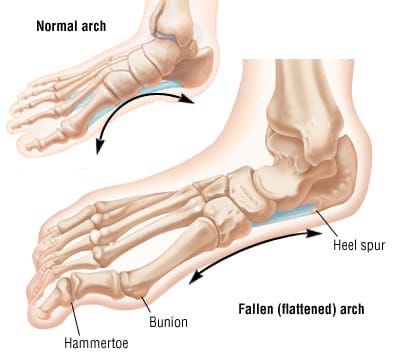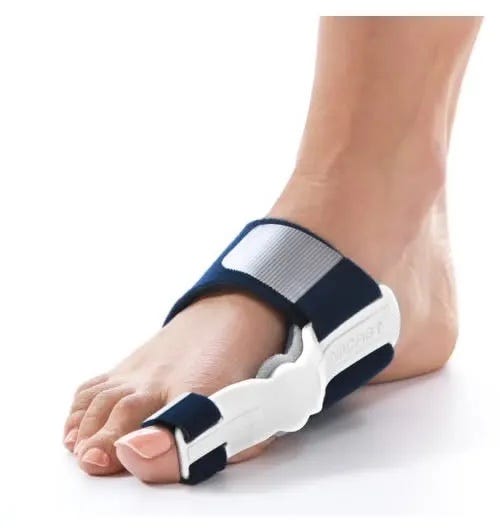Bunions - Overview
What is a bunion?
A bunion is a painful bump located at the base of the big toe joint (MTP). Bunions are often referred to as a hallux valgus deformity and occur as a result of stress on the MTP joint over many years of improper foot mechanics. As a bunion begins to form, there is more instability in the arch of the foot which can cause it to fall. A fallen arch puts additional stress on the bunion site, which in turn continues the cycle for further bunion development.
Individuals who walk with their foot pronated (flat footed) or turned out (‘duck footed’) are also at an increase risk of developing a bunion. This is because those foot mechanics put additional stress on the 1st metatarsal bone (just below bunion site) during the toe-off phase of walking.
Bunions present in both adults or adolescents; primarily women.


Causes:
- Inherited Foot Type (flatfeet)
- Foot Stress or Injuries
- Deformities present at birth (Congenital Hallux Valgus)
- Walking with turned out feet (‘duck footed’)
Symptoms:
- Painful and swollen bump at the MTP joint
- Stiffened joint while walking (causing a burning sensation)
- Numbness in the big toe
- Irritation with long periods of standing
Risk Factors:
- Ill-fitting shoes: People who wear shoes that are too tight, too narrow or too pointed are more likely to speed up the development of bunions.
- Rheumatoid arthritis: Having this inflammatory condition can make you more likely to develop bunions.
- Hereditary: The tendency to develop bunions might be the result of an inherited with the structure or anatomy of your foot.
Progression:
Bunions develop slowly over time. Pressure on the MTP joint while walking causes the big toe to lean inwards, towards the second toe. Over time, the normal structure of the bone changes, resulting in a bump. This deformity will gradually increase and may make it painful to wear shoes or walk. Improper footwear can crowd the toes and speed up the progression of a bunion.
Bracing and Support Options for Bunions
Rigid bunion splints can resist the inward pull from toe muscles to prevent further bunion development, while simultaneously guiding the big toe toward normal alignment. The lining is padded with soft foam to relieve pressure that causes bunion pain. These splints will not prevent a bunion from occurring, but may help alleviate pressure and pain in early stages.
OS1st HV3 Bunion Bracing Sleeve:
This product is designed to reduce pressure in the shoe, realign the big toe, and stretch tendons and toe muscles. The HV3 would not be effective for moderate or severe bunions as it lacks the strength to provide adequate support for the bunion.
The major advantage of a hinged bunion splint is that the hinge allows the big toe to flex when walking and also adapts to the contour of the irritated joint area. A hinged bunion splint reduces toe joint strain and enhances the distribution of pressure throughout the foot. A great benefit of this product is that the hinge also can be locked for night-time immobilization.
Aircast SofToes Bunion Protector:
These ergonomic cushions help provide gentle protection, soft comfort and secure support, while a subtle hint of menthol helps maintain a fresh, airy smell.
Also note, bunions progress from improper foot mechanics so properly fitting orthotics can also encourage proper loading mechanics in the foot. Here are some insole and insert options we carry.
Browse of our products to treat bunions, like these:
































